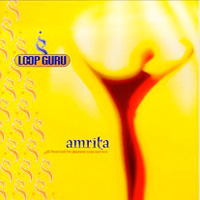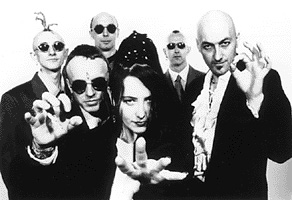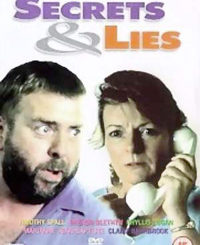 Loop Guru
Loop Guru
Amarita (World Domination)
An interview with Salman Gita (Sam Dodson)
by Lex Marburger
The first time I saw them, I was blown away. The second time, I was forcibly stunned. Loop Guru has undeniably won my award for best live show. The energy they create had me dancing furiously, without stopping for their entire set. Their albums, Amarita (All These and the Japanese Soup Warriors), and Loop Bites Dog, both on World Domination, are incredible in themselves for their sheer lushness of melody and forest of percussion, but it is the live show that sets them apart. Listen in.
Just to clarify to everyone who doesn’t know, you have what, three drummers?
Absolutely. But they’re not drum sets. Well, half drum sets and half-built bits of scraps of metal, anything we can find, anything that creates sound. The sound is the most important thing. We can’t just use bicycle wheels and stuff like that, everything has to sound spot on. Yeah, three percussionists generally when we play live, and loads of other stuff being… hit.
How do you find the stuff? Do you just walk around and say “that sounds great!”
Yeah. (laughs) If we’re on the tour bus and we go by a dump ground or something, we always stop and leap out, wandering around with drumsticks in our hands, hit things, pick them up, try them out.
You use samples in addition to all those drummers. Where did you get the idea?
It kind of grooves spontaneously, really. Much more of a live element. We wanted to get a tribal thing going. And sampling and looping a drum track the whole time can get a bit… dull, I’m afraid. We like to rev things up a bit.
How did you find all these diverse people to play with you?
I suppose it’s been playing around London for the last X amount of years, and the people we’ve picked up along the way, the ones that fit in to the same ideology we had, and still have. I mean, it’s still developing. There have been some people who have been in Loop Guru for at least ten years.
Where do the samples and loops come from?
Records, tapes, radio, all sorts of stuff. Any musical, or non-musical sound; we collect avidly. We wander around with DAT machines recording bits and pieces, hitting things. The bits of metal we can’t collect, we tape. Like the twenty foot dumpsters. We hit those. (laughs)
The sound of the music often has a Middle Eastern quality to it, rather unlike London.
Well, London is a very multicultural melange of stuff, and there are certain areas of London that are very Asian, certain areas that are Jamaican. There are communities all over London, and I feel very attached to them. They’re the communities that give London its color. I’ve grown up with Asian music, reggae, you name it. It seems very natural to me, especially when I grew bored of guitar/drums. I looked outside of my culture for inspiration, and I found it in jazz, Middle Eastern music, Asian music… with the help of people like George Harrison along the way.
 In the liner notes for your album Amarita…, there’s a credit in every song for “Speechless.”
In the liner notes for your album Amarita…, there’s a credit in every song for “Speechless.”
It’s the Third Mind. When me and Jarmud get together and write, there’s an extra force most definitely in operation. It’s a random, symbolistic, symbiotic thing that’s indescribable, so it becomes “Speechless.” Not a person, but a… presence. The inspiration comes straight out of nowhere.
The melodies created… are they sampled as well?
They’re all sorts of things. Samples of bands… anything. Very carefully chosen. It takes anywhere from three hours to a week to put a song together, and even then… we’ve been working on a song that we started a year ago. My favorite ones are the songs that take only a few hours, because something just clicks, and it becomes so easy that we just sit around and giggle. It’s laughingly simple, and sometimes it’s terrifyingly difficult. There is no telling. When things start to get difficult, we start to get much more random. Like pulling tapes off the shelves without looking. If we let our egos get in there too much, there’s not enough room for Speechless. If we become invisible, it all comes very fast.
The art of becoming invisible.
It’s like the song’s already there, we just have to make sure we get it right. We take out everything that’s not the song a lot. We always come out of the studio with mixes that have nothing to do with the original.
How do you come up with the drum beats?
We im-pro-vise. Often the very simplest beats are the sequenced ones, except for the jungle beats, which are impossible to play. Although, if you look very carefully, you’ll see Jim playing live jungle. I think our fastest tune is about 166 bpm, and he’s playing jungle beats along with that. It’s rather impressive.
When playing live, playing to sequences, do you have the option to completely take off outside the song, and play something completely new?
Yeah. We do. It depends very much on where we are, as to the monitors and things like that. There are certain situations that we know it will work… it’s all about the sound system and how much echo there is in a place. Sometimes where we play makes it very difficult, and sometimes, it’s easy, so when it is easy, we let loose a lot more. Sometimes we go without sequences for five or six minutes. We have triggers and tapes for the samples, so sometimes we can throw in a sample or two. We don’t use headphones, so that’s why we need a good monitor system. Headphones become too impersonal, they create a degree of separation from the rest of the band as well as the audience, and one of the most important things at our shows is to connect, and make them feel they’re part of the show, because without them, we’re bollocks (laughs). We need their feedback, their energy, then we can create more energy, and they give us even more, and then we can fly, and they can fly, and… who knows?



